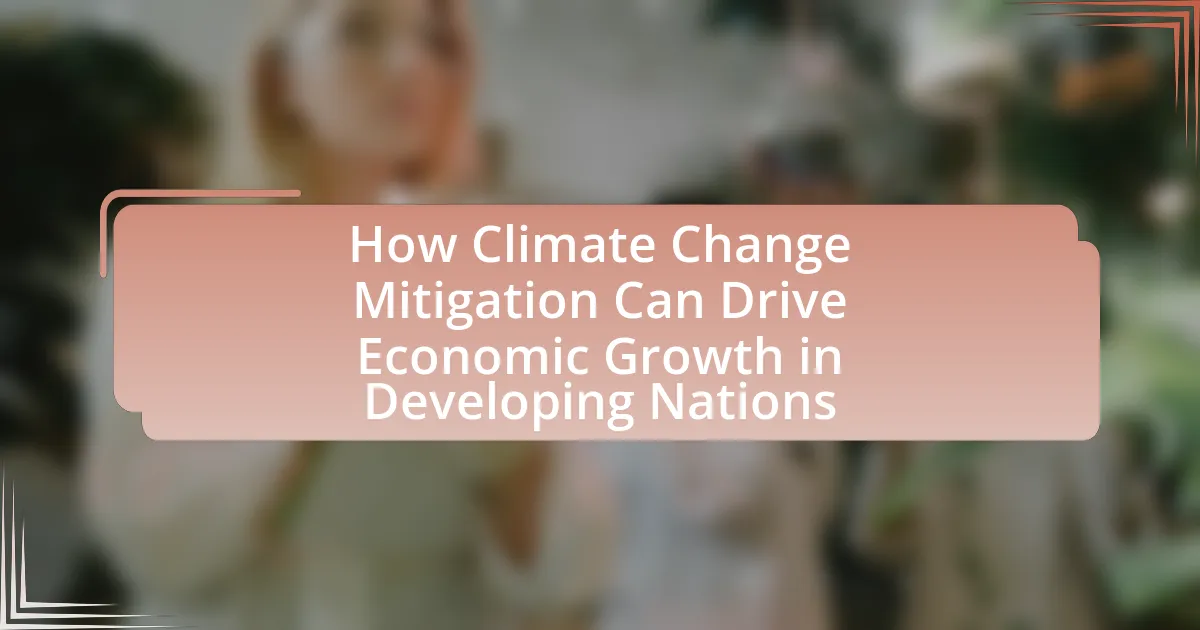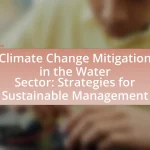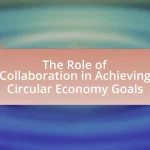Climate change mitigation is a critical focus for developing nations, as it involves reducing greenhouse gas emissions to combat global warming and protect vulnerable populations from climate-related impacts. The article explores the importance of climate change mitigation for economic growth in these countries, highlighting strategies such as transitioning to renewable energy, enhancing energy efficiency, and promoting sustainable agriculture. It discusses the economic benefits of these strategies, including job creation and improved public health, while also addressing the challenges faced by developing nations, such as financial constraints and technological gaps. Additionally, the article emphasizes the role of governance and international collaboration in overcoming these barriers and driving sustainable development through climate action.
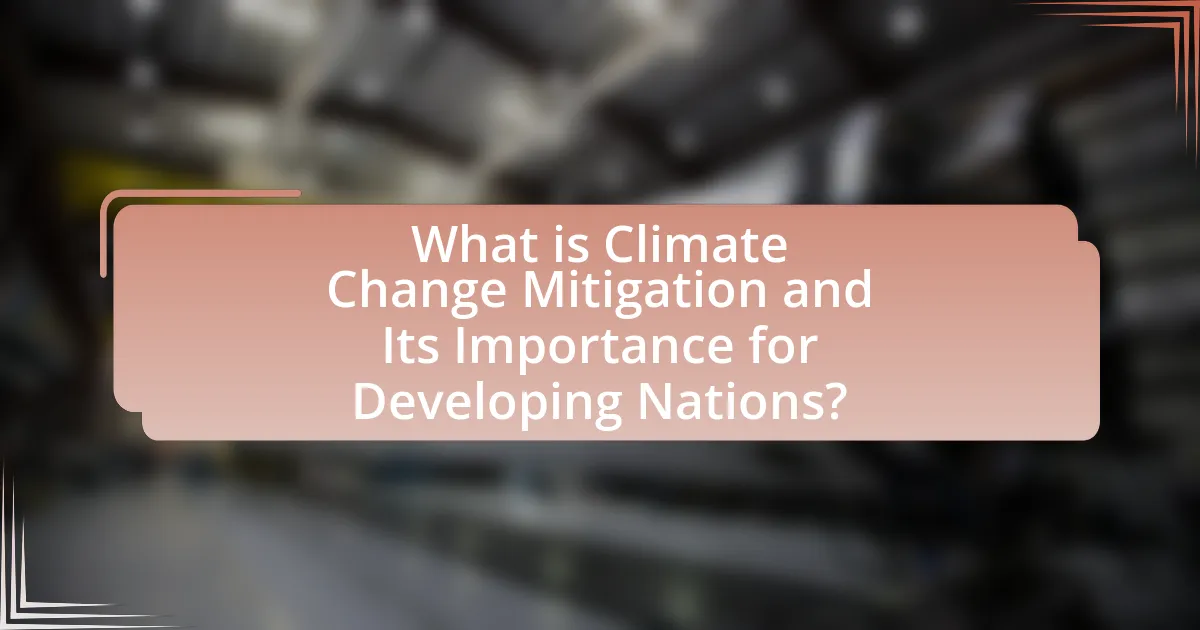
What is Climate Change Mitigation and Its Importance for Developing Nations?
Climate change mitigation refers to efforts aimed at reducing or preventing the emission of greenhouse gases to limit global warming. For developing nations, climate change mitigation is crucial as it helps protect vulnerable populations from the adverse effects of climate change, such as extreme weather events and food insecurity. According to the Intergovernmental Panel on Climate Change (IPCC), developing countries are disproportionately affected by climate change due to their limited adaptive capacity and reliance on climate-sensitive sectors like agriculture. By investing in renewable energy and sustainable practices, these nations can not only reduce emissions but also stimulate economic growth, create jobs, and enhance resilience against climate impacts.
How does climate change mitigation impact economic growth?
Climate change mitigation positively impacts economic growth by fostering innovation, creating jobs, and enhancing resilience against climate-related disruptions. For instance, investments in renewable energy technologies can lead to the development of new industries and job opportunities; the International Renewable Energy Agency reported that the renewable energy sector employed over 11 million people globally in 2018, a number that continues to grow. Additionally, transitioning to sustainable practices can improve resource efficiency, reducing costs for businesses and consumers alike. A study by the Global Commission on the Economy and Climate found that bold climate action could deliver at least $26 trillion in economic benefits by 2030, demonstrating a clear link between climate mitigation efforts and economic growth.
What are the key strategies for climate change mitigation?
Key strategies for climate change mitigation include transitioning to renewable energy sources, enhancing energy efficiency, and promoting sustainable land use practices. Transitioning to renewable energy, such as solar and wind, can significantly reduce greenhouse gas emissions; for instance, the International Renewable Energy Agency reported that renewable energy could account for 86% of global power demand by 2050. Enhancing energy efficiency in buildings and industries can lower energy consumption and emissions, with studies indicating that energy efficiency measures could reduce global energy demand by 40% by 2040. Promoting sustainable land use practices, including reforestation and sustainable agriculture, can sequester carbon and improve resilience to climate impacts, as evidenced by the Intergovernmental Panel on Climate Change, which highlights that land management can contribute to up to 30% of the mitigation needed by 2030.
How do these strategies differ in developing nations compared to developed nations?
Strategies for climate change mitigation in developing nations focus on sustainable development and capacity building, while developed nations emphasize technological innovation and regulatory frameworks. Developing nations often prioritize low-cost, community-based solutions due to limited financial resources, such as renewable energy projects that utilize local materials and labor. In contrast, developed nations leverage advanced technologies and significant investments to implement large-scale renewable energy systems and carbon pricing mechanisms. For instance, the International Renewable Energy Agency reported that developing countries are increasingly investing in solar and wind energy, which can provide affordable energy access, while developed countries have the infrastructure to support complex emissions trading systems. This distinction highlights the varying approaches based on economic capabilities and resource availability.
Why is climate change mitigation crucial for sustainable development?
Climate change mitigation is crucial for sustainable development because it directly addresses the environmental challenges that threaten economic stability and social equity. Effective mitigation strategies reduce greenhouse gas emissions, which are responsible for global warming and its associated impacts, such as extreme weather events, food insecurity, and health risks. According to the Intergovernmental Panel on Climate Change (IPCC), limiting global warming to 1.5 degrees Celsius can significantly reduce the risks of these adverse effects, thereby fostering a more resilient economy and society. By investing in renewable energy and sustainable practices, developing nations can create jobs, enhance energy security, and promote long-term economic growth while ensuring that environmental resources are preserved for future generations.
What role does climate change play in economic instability in developing nations?
Climate change significantly contributes to economic instability in developing nations by exacerbating vulnerabilities in agriculture, infrastructure, and health systems. For instance, rising temperatures and unpredictable weather patterns lead to reduced crop yields, threatening food security and livelihoods. According to the Intergovernmental Panel on Climate Change (IPCC), agricultural productivity in many developing regions could decline by up to 30% by 2050 due to climate impacts. Additionally, extreme weather events, such as floods and droughts, damage infrastructure, leading to costly repairs and disruptions in economic activities. The World Bank estimates that climate change could push over 100 million people into extreme poverty by 2030, highlighting the direct link between climate-related challenges and economic instability.
How can climate change mitigation enhance resilience in vulnerable economies?
Climate change mitigation enhances resilience in vulnerable economies by reducing their exposure to climate-related risks and fostering sustainable development. Implementing renewable energy sources, for example, decreases reliance on fossil fuels, which can be subject to volatile prices and supply disruptions. According to the International Renewable Energy Agency, transitioning to renewable energy can create jobs and stimulate economic growth, thereby strengthening local economies against climate impacts. Additionally, investing in climate-resilient infrastructure, such as flood defenses and drought-resistant agriculture, can protect communities from extreme weather events, which are becoming more frequent due to climate change. This proactive approach not only safeguards livelihoods but also promotes long-term economic stability, as evidenced by the World Bank’s findings that climate-smart investments can yield significant returns in terms of reduced disaster recovery costs and enhanced food security.
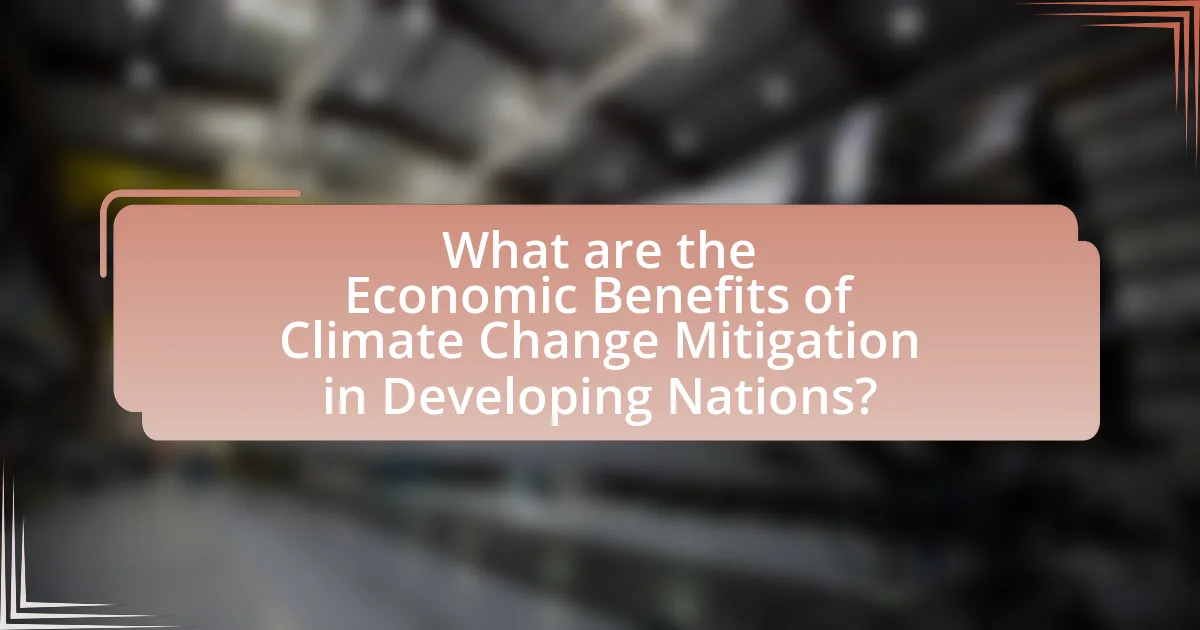
What are the Economic Benefits of Climate Change Mitigation in Developing Nations?
The economic benefits of climate change mitigation in developing nations include enhanced resilience, job creation, and improved public health. By investing in renewable energy and sustainable practices, developing nations can reduce their vulnerability to climate impacts, which in turn stabilizes their economies. For instance, the International Renewable Energy Agency reported that transitioning to renewable energy could create up to 24 million jobs globally by 2030, with a significant portion in developing countries. Additionally, climate mitigation efforts can lead to better air quality and reduced healthcare costs, as evidenced by a study from the World Health Organization, which found that cleaner air could save billions in health expenditures. Thus, climate change mitigation not only addresses environmental concerns but also fosters economic growth and social well-being in developing nations.
How can green technologies drive economic growth?
Green technologies can drive economic growth by creating new markets and job opportunities while enhancing energy efficiency. For instance, the global renewable energy sector employed over 11 million people in 2018, with projections indicating continued growth as investments in solar, wind, and other sustainable technologies increase. Additionally, green technologies reduce reliance on fossil fuels, leading to lower energy costs and improved energy security, which can stimulate economic activity. Countries that invest in green technologies often experience increased innovation and competitiveness, as seen in Germany’s transition to renewable energy, which has bolstered its economy and created a robust export market for green technology products.
What types of green technologies are most applicable in developing nations?
Renewable energy technologies, such as solar, wind, and biomass, are the most applicable green technologies in developing nations. These technologies provide sustainable energy solutions that can reduce reliance on fossil fuels, which are often expensive and environmentally damaging. For instance, solar energy systems can be deployed in remote areas where grid access is limited, enabling communities to harness abundant sunlight for electricity. According to the International Renewable Energy Agency, solar power installations in developing countries have increased significantly, with over 100 million people gaining access to electricity through off-grid solar solutions by 2020. Wind energy also presents a viable option, particularly in regions with favorable wind conditions, contributing to energy diversification and job creation. Additionally, biomass energy can utilize local agricultural waste, providing both energy and a means to manage waste effectively. These technologies not only address energy needs but also promote economic growth by creating jobs and fostering local industries.
How do these technologies create jobs and stimulate local economies?
Technologies aimed at climate change mitigation create jobs and stimulate local economies by fostering new industries and enhancing existing ones. For instance, the renewable energy sector, which includes solar and wind energy, has seen significant growth, leading to the creation of over 11 million jobs globally as reported by the International Renewable Energy Agency in 2018. These jobs range from manufacturing and installation to maintenance and research, directly benefiting local communities through employment opportunities. Additionally, investments in green technologies often lead to infrastructure improvements, which can enhance local business operations and attract further investment, thereby stimulating economic growth.
What financial opportunities arise from climate change mitigation?
Financial opportunities arising from climate change mitigation include investments in renewable energy, energy efficiency technologies, and sustainable agriculture. These sectors are projected to grow significantly; for instance, the International Renewable Energy Agency estimates that the renewable energy sector could create up to 24 million jobs globally by 2030. Additionally, transitioning to energy-efficient practices can lead to cost savings for businesses and consumers, with the potential to save $1 trillion annually by 2030 according to the Global Energy Efficiency Accelerator Platform. Sustainable agriculture practices not only enhance food security but also open up new markets for eco-friendly products, contributing to economic growth in developing nations.
How can international funding and investments support mitigation efforts?
International funding and investments can significantly support mitigation efforts by providing the necessary financial resources for sustainable projects and technologies. These funds enable developing nations to implement renewable energy solutions, enhance energy efficiency, and adopt climate-resilient agricultural practices. For instance, the Green Climate Fund has allocated billions to support projects that reduce greenhouse gas emissions and promote sustainable development in vulnerable countries. Additionally, investments in clean technology can create jobs and stimulate economic growth, as evidenced by the International Renewable Energy Agency’s report indicating that renewable energy jobs reached 11.5 million globally in 2018, showcasing the potential for economic benefits alongside environmental protection.
What are the potential returns on investment for climate-friendly initiatives?
Climate-friendly initiatives can yield significant returns on investment, often exceeding traditional investments. For instance, a report by the Global Commission on the Economy and Climate indicates that transitioning to a low-carbon economy could generate $26 trillion in economic benefits by 2030, primarily through increased energy efficiency, job creation in renewable energy sectors, and reduced health costs from pollution. Additionally, investing in sustainable infrastructure can lead to a return of up to $4 for every $1 spent, as evidenced by various case studies in developing nations where green projects have stimulated local economies and improved resilience against climate impacts.
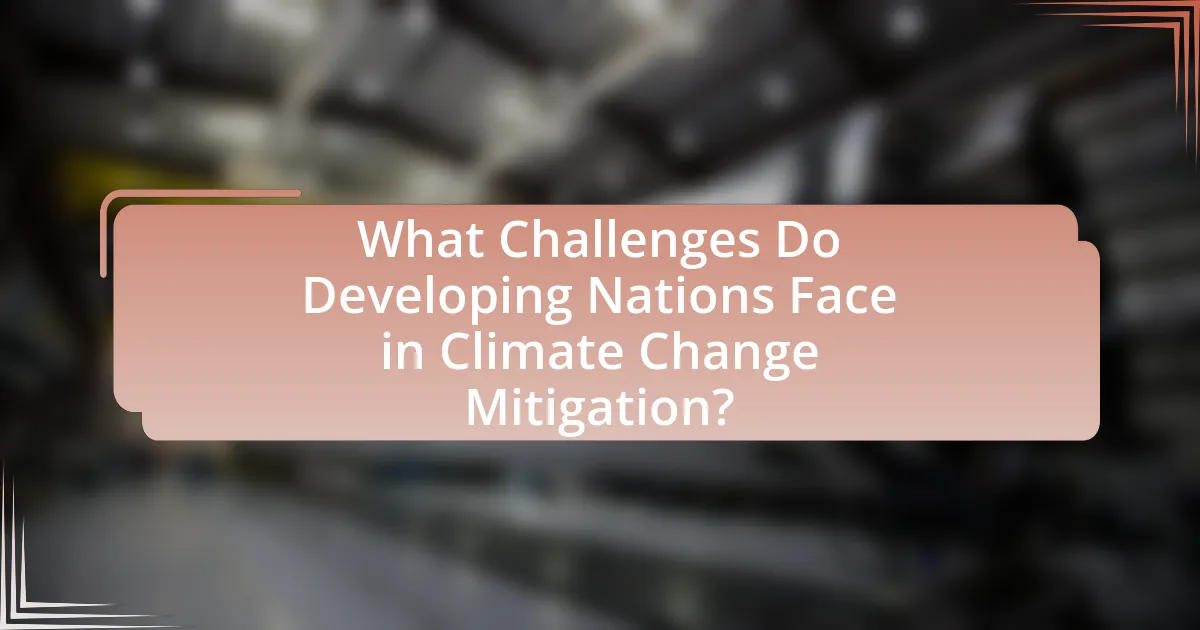
What Challenges Do Developing Nations Face in Climate Change Mitigation?
Developing nations face significant challenges in climate change mitigation, primarily due to limited financial resources, inadequate technology, and insufficient institutional capacity. These nations often lack the funding necessary to implement sustainable practices, with estimates indicating that developing countries require $140 billion to $300 billion annually to address climate change effectively. Additionally, the technological gap hinders their ability to adopt renewable energy sources and improve energy efficiency. For instance, a report by the United Nations Environment Programme highlights that many developing countries rely heavily on fossil fuels due to the lack of access to advanced technologies. Furthermore, weak governance structures and limited expertise in climate policy formulation impede effective action, as noted in the World Bank’s analysis of climate resilience in low-income countries.
What are the main barriers to implementing climate change mitigation strategies?
The main barriers to implementing climate change mitigation strategies include financial constraints, lack of political will, and insufficient technological capacity. Financial constraints hinder investment in renewable energy and infrastructure, as many developing nations face budget limitations and reliance on fossil fuels. Lack of political will often results in inadequate policy frameworks and enforcement mechanisms, which are essential for effective climate action. Additionally, insufficient technological capacity limits the ability to adopt and implement innovative solutions for reducing greenhouse gas emissions. For instance, according to the United Nations Environment Programme, developing countries require an estimated $140 billion annually to meet their climate goals, highlighting the financial barrier.
How do economic constraints limit mitigation efforts?
Economic constraints limit mitigation efforts by restricting financial resources necessary for implementing climate change strategies. Developing nations often face budget deficits, high debt levels, and limited access to international funding, which hinder their ability to invest in renewable energy, infrastructure improvements, and technology transfer. For instance, a report by the United Nations Environment Programme indicates that developing countries require $140 billion annually to meet their climate goals, yet many lack the financial capacity to mobilize such funds. Consequently, these economic limitations result in delayed or inadequate responses to climate change, ultimately exacerbating environmental degradation and hindering sustainable development.
What role does governance play in overcoming these barriers?
Governance plays a critical role in overcoming barriers to climate change mitigation in developing nations by establishing frameworks that promote accountability, transparency, and effective resource allocation. Effective governance ensures that policies are implemented efficiently, enabling the mobilization of financial resources and technology transfer necessary for sustainable development. For instance, countries with strong governance structures, such as those adhering to the principles of the Paris Agreement, have shown improved capacity to attract foreign investment in green technologies, which is essential for economic growth while addressing climate challenges. Additionally, robust governance mechanisms facilitate stakeholder engagement, ensuring that local communities are involved in decision-making processes, thereby enhancing the effectiveness of climate initiatives.
How can developing nations overcome these challenges?
Developing nations can overcome challenges related to climate change by investing in renewable energy sources, enhancing infrastructure resilience, and promoting sustainable agricultural practices. For instance, transitioning to solar and wind energy can reduce reliance on fossil fuels, which is crucial as the International Renewable Energy Agency reported that renewable energy could create up to 24 million jobs globally by 2030. Additionally, improving infrastructure to withstand climate impacts, such as flooding and extreme weather, can protect economic assets and livelihoods. The Food and Agriculture Organization emphasizes that sustainable agricultural practices can increase food security and reduce emissions, thereby supporting economic growth while addressing climate challenges.
What best practices can be adopted from successful mitigation examples?
Best practices that can be adopted from successful mitigation examples include implementing renewable energy projects, enhancing energy efficiency, and promoting sustainable agriculture. For instance, countries like Costa Rica have successfully transitioned to renewable energy sources, achieving over 99% of their electricity from renewables, which demonstrates the viability of such initiatives. Additionally, energy efficiency measures, such as those adopted in Germany, have led to significant reductions in energy consumption while maintaining economic growth. Sustainable agriculture practices, as seen in various African nations, not only mitigate climate impacts but also improve food security and local economies. These examples provide concrete evidence that integrating these practices can effectively drive economic growth while addressing climate change challenges in developing nations.
How can collaboration between nations enhance mitigation efforts?
Collaboration between nations can enhance mitigation efforts by facilitating the sharing of resources, technology, and best practices. When countries work together, they can pool financial resources to fund large-scale renewable energy projects, as seen in initiatives like the Green Climate Fund, which has mobilized billions to support climate action in developing nations. Additionally, collaborative research and development can lead to innovative solutions, such as carbon capture technologies, which have been advanced through international partnerships like the Carbon Capture and Storage Association. Furthermore, joint commitments to emissions reduction, exemplified by agreements like the Paris Accord, create accountability and encourage nations to meet their climate goals collectively, ultimately leading to more effective and comprehensive mitigation strategies.
What practical steps can developing nations take to drive economic growth through climate change mitigation?
Developing nations can drive economic growth through climate change mitigation by investing in renewable energy sources, enhancing energy efficiency, and promoting sustainable agriculture practices. By transitioning to renewable energy, such as solar and wind, these nations can reduce dependence on fossil fuels, which not only lowers greenhouse gas emissions but also creates jobs in the green energy sector. For instance, the International Renewable Energy Agency reported that renewable energy jobs reached 11.5 million globally in 2018, with significant growth potential in developing regions.
Additionally, improving energy efficiency in industries and buildings can lead to cost savings and increased productivity. The Global Energy Efficiency Accelerator Platform indicates that energy efficiency measures can reduce energy consumption by up to 30%, providing economic benefits while mitigating climate impacts.
Furthermore, promoting sustainable agriculture practices, such as agroforestry and organic farming, can enhance food security and increase farmers’ incomes. The Food and Agriculture Organization highlights that sustainable practices can improve crop yields and resilience to climate change, contributing to economic stability.
By implementing these practical steps, developing nations can align economic growth with climate change mitigation, fostering a sustainable future.
